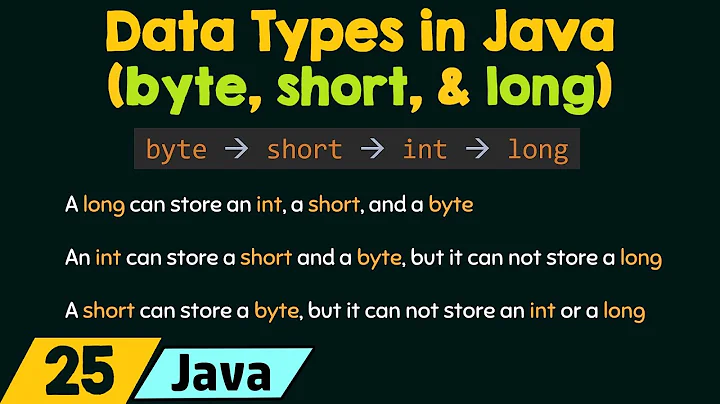Difference between long and int data types
Solution 1
From this reference:
An int was originally intended to be the "natural" word size of the processor. Many modern processors can handle different word sizes with equal ease.
Also, this bit:
On many (but not all) C and C++ implementations, a long is larger than an int. Today's most popular desktop platforms, such as Windows and Linux, run primarily on 32 bit processors and most compilers for these platforms use a 32 bit int which has the same size and representation as a long.
Solution 2
The guarantees the standard gives you go like this:
1 == sizeof(char) <= sizeof(short) <= sizeof (int) <= sizeof(long) <= sizeof(long long)
So it's perfectly valid for sizeof (int) and sizeof (long) to be equal, and many platforms choose to go with this approach. You will find some platforms where int is 32 bits, long is 64 bits, and long long is 128 bits, but it seems very common for sizeof (long) to be 4.
(Note that long long is recognized in C from C99 onwards, but was normally implemented as an extension in C++ prior to C++11.)
Solution 3
You're on a 32-bit machine or a 64-bit Windows machine. On my 64-bit machine (running a Unix-derivative O/S, not Windows), sizeof(int) == 4, but sizeof(long) == 8.
They're different types — sometimes the same size as each other, sometimes not.
(In the really old days, sizeof(int) == 2 and sizeof(long) == 4 — though that might have been the days before C++ existed, come to think of it. Still, technically, it is a legitimate configuration, albeit unusual outside of the embedded space, and quite possibly unusual even in the embedded space.)
Solution 4
On platforms where they both have the same size the answer is nothing. They both represent signed 4 byte values.
However you cannot depend on this being true. The size of long and int are not definitively defined by the standard. It's possible for compilers to give the types different sizes and hence break this assumption.
Solution 5
The long must be at least the same size as an int, and possibly, but not necessarily, longer.
On common 32-bit systems, both int and long are 4-bytes/32-bits, and this is valid according to the C++ spec.
On other systems, both int and long long may be a different size. I used to work on a platform where int was 2-bytes, and long was 4-bytes.
Related videos on Youtube
S. Plekhanov
Updated on May 22, 2020Comments
-
S. Plekhanov almost 4 years
Considering that the following statements return
4, what is the difference between theintandlongtypes in C++?sizeof(int) sizeof(long)-
 Martin York almost 15 yearsAsked and answered: stackoverflow.com/questions/271076/…
Martin York almost 15 yearsAsked and answered: stackoverflow.com/questions/271076/… -
rxantos almost 2 yearsOn 16 bit machines an int is 2 bytes. while a long remains 4 bytes. int used to be defined as the maximum integer size that a machine can take in one step. I say used to be as on Windows 64 it remained 4 bytes.
-
-
 Jonathan Leffler almost 15 yearsOf course - but I'm not using 64-bit Windows machine. But yes, my statement "You're on a 32-bit machine" is too sweeping; it could be "You're on a 32-bit machine or a Windows machine" which would be pedantically accurate.
Jonathan Leffler almost 15 yearsOf course - but I'm not using 64-bit Windows machine. But yes, my statement "You're on a 32-bit machine" is too sweeping; it could be "You're on a 32-bit machine or a Windows machine" which would be pedantically accurate. -
Craig Lewis almost 15 yearsThis is a useful bit of info. There are processors+compilers where sizeof(char) != sizeof(short). The details are getting a bit hazy now, but I believe that one processor I've worked on couldn't address less than 16 bits. The compiler had to do a lot of work to make sizeof(char) == 1.
-
Steve Jessop almost 15 yearsI don't think your first statement was inaccurate so much as a fair guess. I'm worried the second one might cause people to incorrectly think that your longs are 8 bytes as a necessary consequence of your machine being 64bit, when actually it's a circumstantial property of your compiler.
-
jogojapan almost 11 yearsThere is no need to define them; they are already included in a Standard header file called
<cstdint>, see here: en.cppreference.com/w/cpp/types/integer -
fwlx almost 11 years@jogojapan yeah, we should always prefer standard definitions if possible. But if the code needs enough compatibility to compile on some old OS/compiler, then coding such stuff manually will ensure it. Every option has some goods and bads :)
-
Walter Tross over 10 years@CraigLewis: you mean "...where
sizeof(char)==sizeof(short)", correct? -
 Jonathan Leffler over 9 yearsI believe some of the Cray machines had
Jonathan Leffler over 9 yearsI believe some of the Cray machines hadsizeof(char) == sizeof(short) && sizeof(char) == sizeof(int) && sizeof(int) == 1, and that size was at least 32 bits. -
 AliciaBytes about 9 yearsCray machines, especially Cray SV1 were interesting. They had 8bit chars. Declaring a single char would occupy the whole 64 bit word and waste some space. For an array of chars or multiple chars in a struct the compiler would automatically pack the 8bit chars together in the 64bit words. char pointers were also bigger than other pointers, they had to store the address of the 64bit word, as well as where in the word the packed char was.
AliciaBytes about 9 yearsCray machines, especially Cray SV1 were interesting. They had 8bit chars. Declaring a single char would occupy the whole 64 bit word and waste some space. For an array of chars or multiple chars in a struct the compiler would automatically pack the 8bit chars together in the 64bit words. char pointers were also bigger than other pointers, they had to store the address of the 64bit word, as well as where in the word the packed char was. -
Cookie almost 9 yearsA lot of people are on 64 bit windows. That is a very large group of people to whom you gave the incorrect size of
sizeof(long), which is hardly pedantic. So I am with Steve. -
 Jonathan Leffler almost 9 years@Cookie: In 2009, very many fewer people were using 64-bit Windows. These days, very many more people are using 64-bit Windows.
Jonathan Leffler almost 9 years@Cookie: In 2009, very many fewer people were using 64-bit Windows. These days, very many more people are using 64-bit Windows.









